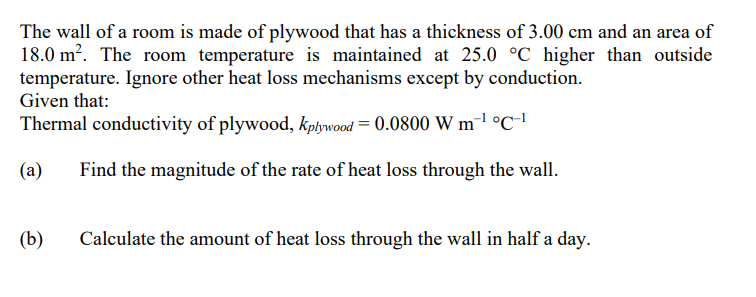The wall of a room is made of plywood that has a thickness of 3.00 cm and an area of 18.0 m?. The room temperature is maintained at 25.0 °C higher than outside temperature. Ignore other heat loss mechanisms except by conduction. Given that: Thermal conductivity of plywood, kpływood = 0.0800 W m¯1 °C-' (a) Find the magnitude of the rate of heat loss through the wall. (b) culate the amount of heat loss through the wall in half a day.
The wall of a room is made of plywood that has a thickness of 3.00 cm and an area of 18.0 m?. The room temperature is maintained at 25.0 °C higher than outside temperature. Ignore other heat loss mechanisms except by conduction. Given that: Thermal conductivity of plywood, kpływood = 0.0800 W m¯1 °C-' (a) Find the magnitude of the rate of heat loss through the wall. (b) culate the amount of heat loss through the wall in half a day.
Principles of Heat Transfer (Activate Learning with these NEW titles from Engineering!)
8th Edition
ISBN:9781305387102
Author:Kreith, Frank; Manglik, Raj M.
Publisher:Kreith, Frank; Manglik, Raj M.
Chapter4: Numerical Analysis Of Heat Conduction
Section: Chapter Questions
Problem 4.12P
Related questions
Question
PLEASE HELP ANSWER THIS

Transcribed Image Text:The wall of a room is made of plywood that has a thickness of 3.00 cm and an area of
18.0 m?. The room temperature is maintained at 25.0 °C higher than outside
temperature. Ignore other heat loss mechanisms except by conduction.
Given that:
Thermal conductivity of plywood, kpływood = 0.0800 W m¯1 °C-'
(a)
Find the magnitude of the rate of heat loss through the wall.
(b)
Calculate the amount of heat loss through the wall in half a day.
Expert Solution
This question has been solved!
Explore an expertly crafted, step-by-step solution for a thorough understanding of key concepts.
Step by step
Solved in 2 steps

Knowledge Booster
Learn more about
Need a deep-dive on the concept behind this application? Look no further. Learn more about this topic, mechanical-engineering and related others by exploring similar questions and additional content below.Recommended textbooks for you

Principles of Heat Transfer (Activate Learning wi…
Mechanical Engineering
ISBN:
9781305387102
Author:
Kreith, Frank; Manglik, Raj M.
Publisher:
Cengage Learning

Principles of Heat Transfer (Activate Learning wi…
Mechanical Engineering
ISBN:
9781305387102
Author:
Kreith, Frank; Manglik, Raj M.
Publisher:
Cengage Learning